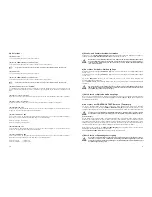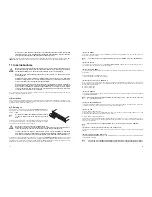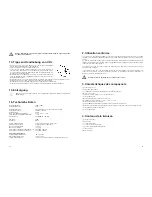
38
h) Synchronisation of the CD speed
To mix or cross-fade two signal sources "cleanly", it is often necessary to synchronise the beat of the two
pieces of music first.
There are two ways of doing this:
1. The playing speed can be changed statically (permanently) with thePITCH slide control. This function is
used if the beat tempo of two tracks is completely different.
2. The playing speed can be changed temporarily with the PITCH bend buttons. This function is used if
two tracks have the same beat but need to be synchonised.
PITCH slide control
1. Switch on the function by pressing in the PITCH button.
2. Select the desired maximum change of pitch of 4%, 8% or 16% with the PITCH % button.
3. Change the playing speed by moving the PITCH slide control upwards or downwards. The respective
variation in speed set is displayed on the LC display. The original playback speed is maintained if the slide
control is set to the central position.
PITCH BEND buttons:
1. Hold down the respective PITCH BEND button during playback to change the speed up to 16 %.
Pitch Bend (-) button = reduction of the speed
Pitch Bend (+) button = increase of the speed
2. The extent to which the playing speed varies depends on how long the PITCH button is pressed.
3. The playing speed specified by the PITCH control slide is returned to after letting go of the button.
i) Playback loop (LOOP function)
This function can be used to define a playback loop. The starting point and end point of the loop can be
selected in playback and pause mode.
1. Press the LOOP-IN button after arriving at the desired starting point. The starting point of the playback
loop is set.
2. Press the LOOP-OUT button after arriving at the desired end point. The yellow LEDs next to the LOOP-
OUT button flash. The set loop is now played. Playback continues until the LOOP function is stopped by
pressing the LOOP-OUT button. The yellow LEDs next to the LOOP-OUT button go on.
3. If the playback loop was stopped, it can be restarted by pressing the RELOOP button. The LOOP-OUT
button must be pressed to end the playback loop.
☞
The existing playback loop is deleted as soon as a new playback loop is programmed.
j) RELAY operation
Tracks of the two CD drives are played alternately with this function. This means the CD in one of the drives
is played as soon as a track on a CD in the other drive has finished.
1. Insert a CD in both CD compartments.
2. Press the RELAY button. The red LED above the button goes on. Single-track playback mode (SINGLE)
is automatically activated on both CD player sides by pressing the RELAY button.
3. Start playing CD player 1. Once CD player 1 has arrived at the end of the track, it switches to pause
mode and CD player 2 automatically starts to play. Once the end of the track (on CD player 2) is reached,
CD-player 1 automatically starts playing the next track, and so on.
4. You must press the RELAY button again to end the RELAY function.
27
Do not leave the appliance unattended while operating it.
• Never place the appliance on an unstable or movable surface. Persons could be injured or the appliance
damaged by it falling down.
• When using a rack, make sure it is in a stable position and is transported securely. Installation on uneven,
slanted surfaces or stopping the rack abruptly during transport can result in the rack overturning or appli-
ances falling from or out of the rack and injuring people.
Live components can be exposed by opening covers or removing components (unless this can
be done without tools). Contact points can also be live. If the appliance has to be opened in order
to calibrate, service, repair or replace components or assemblies, all of its poles must be dis-
connected from all sources of voltage first. If the appliance has to be kept open and under volta-
ge during maintenance or repairs, this work may only be carried out by a specialist who is famili-
ar with the risks involved and the relevant regulations.
• This product is equipped with a laser of class 1. Never open the appliance. Only trained specialists who
are familiar with the respective hazards are permitted to make adjustments or carry out maintenance work.
Adjustments made by unqualified persons could result in dangerous laser radiation.
A laser warning sign is on the back of the appliance and in the CD compartment.
Do not remove the warning signs from the appliance. Do not open up the applian-
ce or try to gain access to the inside of the appliance. Never stare into the laser
beam. Laser radiation can damage your eyes.
• Never connect the appliance directly after transferring it from a cold to a warm room. The condensation
water that forms could destroy the appliance or result in an electric shock. Allow the device to reach room
temperature before connecting it. Wait until the condensation water has evaporated. This can take some
hours.
• Do not place any naked flames such as those of burning candles on or next to the appliance.
• Do not place the appliance on soft surfaces such as carpets or beds. Do not cover the air vents of the
appliance. Do not obstruct the air circulation with objects such as magazines, table cloths or curtains.
This prevents the dissipation of heat from the appliance and can result in overheating.
• Only use the appliance in a moderate climate, not in tropical environments.
• All persons involved in operating, installing and servicing the appliance and putting it into service must be
trained and qualified accordingly and observe these operating instructions.
Defective mains cables may only be replaced by specialists. Danger of electrocution!
• Do not leave the packaging material lying around carelessly since it can become a source of danger for
children playing with it.
• The CD player may be a source of interference to radios or television sets. Keep it therefore a sufficient
distance away from such appliances.
• The accident prevention regulations and the regulations of the employers' liability insurance association
should be observed at commercial institutions.
If you are not sure about the correct connection or if questions arise which are not answered by
the operating instructions, please do not hesitate to contact our technical support or a specialist
of your choice. Consult a specialist if you are in doubt about the operating principle or the safety
of the product.




















